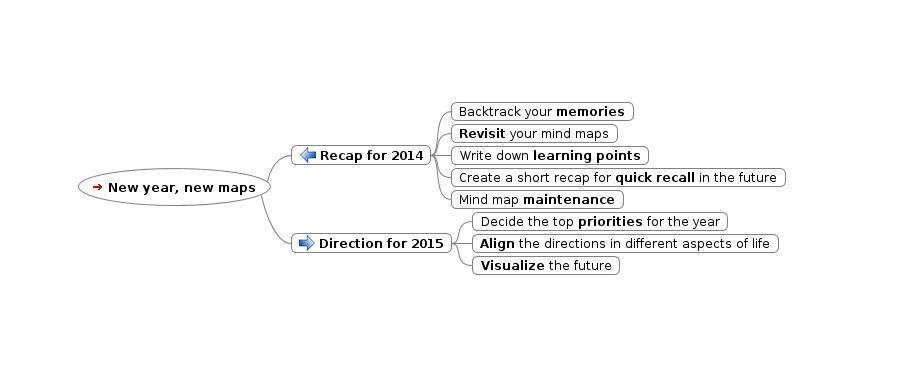New year, new maps

New year, new maps
The time around Christmas and New Year has traditionally been a time for reflection and planning for me. It probably doesn’t come as a surprise that I do it with the help of mind maps.
The exact way I do my annual planning changes from year to year. I keep what works, change what doesn’t. This is how I went about it this time:
I started by creating a new map for my Christmas review. I used that for around two weeks, usually in early mornings and late evenings. I went through what’s happened during the previous year and created plans for the next. I worked in iterations, repeating the process several times over the weeks.
What’s happened? – Recapping the previous year
It takes conscious effort for me nowadays to stop and look back at what’s happened. My normal mindset is quite future oriented, but the maps help me change that. They help me keep focused on the past long enough to gather learning points for the future.
I started by backtracking my memories for the year to see how much I can remember from the top of my head, like in the Self-biography exercise. It’s been a busy year, but it was a surprisingly easy task to do. What I love about travel — I’ve lived on the road for two years now — is how it keeps my brain awake, and the number of things and events I remember afterwards is way more than for those years I’ve stayed put in one place.
I listed down keywords for the year, after which I started reviewing my mind maps. While reviewing old maps, I sometimes add recapping notes to them. I evaluate any written down goals or plans I run into and try to learn from their success or failure. This was also a good time for maintenance tasks: cleaning up cluttered maps, reorganizing data and fixing broken links between maps.
I didn’t limit myself to reviewing just the maps from the last year but went through older material as well. The number of maps and the amount of data in them is too big for a thorough inspection, which means I needed do it by random sampling. In addition to mind maps, I sampled through other sources of documentation, like journals, photos and social media streams.
I want to be able to recall the main points about my year 2014 in seconds.
One goal of the review is to extract the most important pieces of information and insight for the year. I want to create one image, a mind map in this case, that I can use later on to recall the main points of my year 2014 in seconds.
What’s next? – Direction for the upcoming year
After dwelling enough in the past, I can put the past aside and concentrate on the next year instead.
The process I used was based on what I described before in Define your future. I started by defining the direction for a few different areas of my life, both personally and professionally. At first I wrote down a list of everything from the top of my head that I thought I need, want or should do during the next year. I didn’t do much brainstorming for big new ideas since I’m happy with the general direction my life is taking at the moment. For the most parts I want to continue doing what I’m doing now, just doing it even better.
I want to always have something to look forward to.
After figuring out the priorities for the upcoming year I nailed down a few specific dates: one for the spring, one for the fall and one for the winter. The aim is to create an image for each of these dates and to bring elements from all the defined directions to the same picture that I can then visualize in my mind. The images need to be exciting enough that I like to think about them. I want to always have something to look forward to, quite literally.
Doing the future planning over the period of several days has its advantages. One way that planning for yourself differs from planning as a group process is that the outcome is more sensitive to your mental and physical state. You are emotionally more attached to your personal plans, and your emotions are likely to fluctuate, making you value things differently on different days. Planning for your life as a whole is also more complex a task than planning for single business goals. Returning to the task several days in a row increases your chances of creating a balanced plan that takes into account all parts of your life.
The review of the previous year was the more important part to get done right now, since I know I’m unlikely to do that during the year in the middle of everything else. The plan is more like a starting point that I start building on. In January I’ll probably continue to work on it weekly, and after that have monthly checks to see how I’m doing and if the plans need tweaking.

